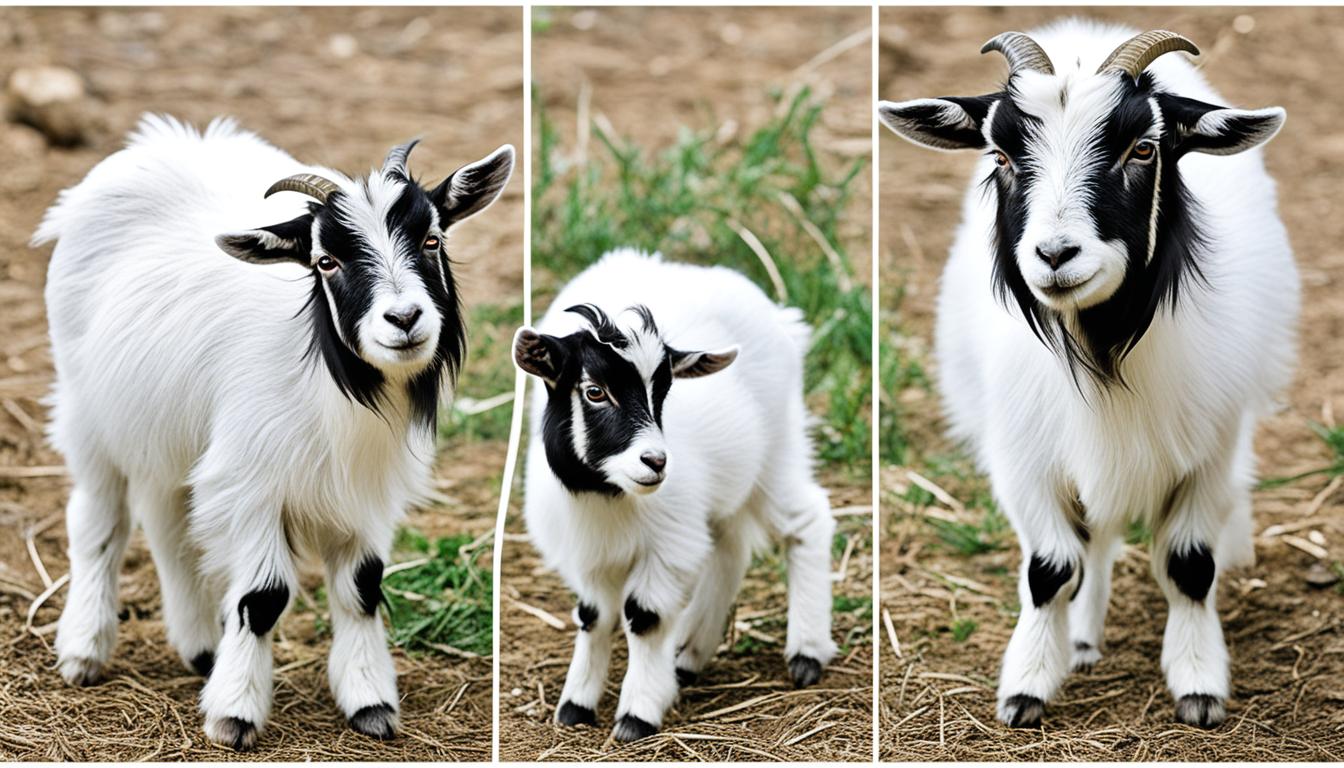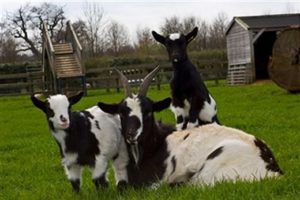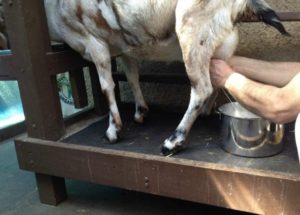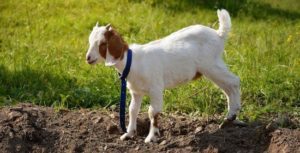Did you know that pygmy goats have a pregnancy duration that is slightly longer than that of larger goat breeds? While it may be surprising, understanding the average pygmy goat gestation period is essential for goat owners and breeders alike. Whether you’re preparing for the arrival of adorable pygmy goat kids or managing your breeding program, knowing the duration of pygmy goat pregnancy is key.
In this section, we will delve into the intricacies of pygmy goat pregnancy, exploring the average pygmy goat pregnancy length and what you can expect during this period. From the stages of pregnancy to signs of labor and post-pregnancy care, we will cover it all to ensure the well-being of your pygmy goats.
Key Takeaways:
- The average pygmy goat gestation period ranges from 145 to 153 days.
- Understanding the stages of pregnancy in pygmy goats is crucial for proper care and preparation.
- Recognizing the signs and symptoms of pregnancy can help you provide the necessary support for your pregnant doe.
- Optimizing pygmy goat health during pregnancy involves proper nutrition, safe housing, and veterinary care.
- Documenting the pygmy goat reproduction timeline is essential for effective breeding management.
Understanding the Pygmy Goat Breeding Cycle
Understanding the pygmy goat breeding cycle is essential for successful reproduction and managing the reproductive health of these miniature goats. By comprehending the various stages of the breeding cycle, including heat periods, mating, and conception, breeders can make informed decisions and promote healthy breeding practices.
The pygmy goat breeding cycle revolves around the doe’s reproductive cycle, which typically lasts about 21 days. During this period, the doe experiences a heat phase, also known as estrus, where she is receptive to mating. It is crucial to carefully observe and track the heat cycles to ensure successful breeding.
Once the doe enters heat, she may exhibit certain behavioral signs such as restlessness, frequent urination, and vocalizations. These signs indicate that she is ready for mating. It is essential to introduce a compatible and healthy buck into the herd during this time to facilitate successful breeding.
When the doe is successfully mated, the fertilization process occurs, and conception takes place. It is important to note that pygmy goats are seasonal breeders, with a higher rate of fertility during the fall and winter months.
After conception, the gestation period begins, during which the fertilized egg develops into a fetus. The average gestation period for pygmy goats is between 145 and 153 days, or approximately 4.5 to 5 months. Monitoring the doe’s pregnancy progress is crucial to ensure proper care and a healthy outcome.
Overall, understanding the pygmy goat breeding cycle enables breeders to optimize their breeding programs and ensure the reproductive health of their goats. By tracking heat periods, facilitating successful mating, and monitoring pregnancy progression, breeders can promote successful reproduction and the birth of healthy pygmy goat kids.
How long are pygmy goats pregnant?
The duration of pygmy goat pregnancy, also known as the gestation period, is an essential consideration for breeders and goat owners. Understanding the average duration of pygmy goat pregnancy is crucial for ensuring the well-being of the pregnant goat and preparing for the arrival of adorable pygmy goat kids.
On average, pygmy goats are pregnant for approximately 145 to 153 days. This gestation period may vary slightly from goat to goat, but this range provides a general guideline for goat owners to anticipate the due date.
To provide a visual representation of the average duration of pygmy goat pregnancy, refer to the table below:
| Duration | Range |
|---|---|
| Minimum | 145 days |
| Average | 149 days |
| Maximum | 153 days |

It’s important to note that individual pygmy goats may have slight variations in their gestation periods, potentially resulting in slightly shorter or longer pregnancies. However, the average range provides a reliable estimate for goat owners to make necessary preparations.
During the gestation period, it’s essential to monitor the health of the pregnant goat closely, ensuring proper nutrition, regular veterinary check-ups, and a comfortable living environment. By providing the necessary care and attention, you can support the well-being of both the mother and the upcoming pygmy goat kids.
Factors That Affect Pygmy Goat Pregnancy Length
Several factors can influence the length of pygmy goat pregnancy. This section will explore three key factors: nutrition and diet, health and veterinary care, and breed specificity and genetics. By understanding how these factors impact pregnancy length, goat owners can make informed decisions to promote healthy pregnancies and ensure successful deliveries.
Nutrition and Diet
The nutrition and diet of pygmy goats play a significant role in their reproductive health and pregnancy length. Providing a balanced diet that meets their nutritional requirements is essential for supporting optimal reproductive function and fetal development. A diet rich in high-quality forage, such as grass hay and fresh pasture, along with appropriate supplementation, can contribute to healthy pregnancies and shorter gestation periods.
Health and Veterinary Care
Ensuring proper health and veterinary care is crucial for maintaining the well-being and fertility of pygmy goats. Regular check-ups, vaccinations, and deworming protocols recommended by a veterinarian can help prevent any underlying health conditions that may impact pregnancy length. Additionally, prompt identification and treatment of any health issues during pregnancy can contribute to successful pregnancies and shorter gestation periods.
Breed Specificity and Genetics
The breed specificity and genetics of pygmy goats can also influence pregnancy length. Different breeds may have variations in their gestation periods due to inherent genetic factors. It is essential to understand the specific traits and genetic characteristics of the pygmy goat breed being bred to anticipate potential variations in pregnancy length. This knowledge can assist in effective breeding management and preparation for the arrival of kids.

| Factor | Impact on Pregnancy Length |
|---|---|
| Nutrition and Diet | A balanced diet can contribute to shorter gestation periods and healthy pregnancies. |
| Health and Veterinary Care | Proper health care and prompt treatment of health issues can prevent complications and ensure successful deliveries. |
| Breed Specificity and Genetics | Genetic factors and breed characteristics may result in variations in pregnancy length. |
Stages of Pregnancy in Pygmy Goats
The journey of pygmy goat pregnancy is a remarkable and dynamic process. It can be divided into several distinct stages, each characterized by specific changes in the doe’s body and the development of the kids. Understanding these stages is essential for goat owners and breeders to provide appropriate care and support throughout the pregnancy.

Conception: The first stage marks the beginning of the pygmy goat’s pregnancy journey. During this period, the female goat, or doe, is successfully fertilized by a male goat, or buck. It is important to ensure proper mating and conception for a successful pregnancy.
Embryonic Development: After conception, the fertilized egg implants into the doe’s uterus and undergoes rapid cell division. This stage is crucial for the development of vital organs and systems in the growing fetus.
Fetal Development: As the pregnancy progresses, the fetus continues to grow and develop. This stage is characterized by the formation of distinct features, such as limbs, facial structures, and the development of the goat’s coat. It is an exciting time as the kids become more recognizable.
Maternal Changes: Throughout the pregnancy, the doe’s body undergoes various physiological changes to accommodate the growing kids. These changes include the enlargement of the udder and the development of milk-producing glands, which are essential for nursing the newborn kids.
Final Preparations for Birth: As the pregnancy nears full term, the doe’s body prepares for labor and delivery. The ligaments around the tailhead and pelvis soften, making it easier for the kids to pass through the birth canal during delivery.
Birth: The final stage of pygmy goat pregnancy is the birth of the kids. This momentous event is marked by the doe going into labor and the subsequent delivery of the newborns. It is a rewarding and joyous occasion for goat owners.
Identifying Pregnancy: Signs and Symptoms in Pygmy Goats
Identifying pregnancy in pygmy goats is essential for ensuring proper care and preparation. By recognizing the signs and symptoms of pregnancy, goat owners can provide the necessary support and ensure the well-being of their pregnant does. This section will explore the behavioral changes and physical development during gestation that can help identify pregnancy in pygmy goats.
Behavioral Changes
When a pygmy goat becomes pregnant, various behavioral changes may occur. These changes can serve as key indicators of pregnancy. Common behavioral changes in pregnant pygmy goats include:
- Decreased activity and less inclination to play or roam
- Increased rest or time spent lying down
- Change in appetite, either increased or decreased
- Seeking solitude or isolation from the herd
- Nesting behavior, such as creating a cozy spot for giving birth
Additionally, pregnant pygmy goats may exhibit increased affection towards their owners or caregivers. While these behavioral changes can vary slightly among individual goats, observing these patterns can help indicate pregnancy.
Physical Development During Gestation
Alongside behavioral changes, physical development is another significant aspect of identifying pregnancy in pygmy goats. As pregnancy progresses, there are observable physical changes in the doe’s body. These changes may include:
- Enlargement of the udder: During the latter stages of pregnancy, the udder will gradually increase in size and become fuller in preparation for milk production.
- Abdominal enlargement: As the kids grow, the doe’s abdomen will expand and become visibly larger.
- Development of mammary glands: The mammary glands will become more pronounced and may feel firmer to the touch.
- Swollen vulva: The vulva of a pregnant pygmy goat may appear swollen or engorged.
Monitoring these physical changes can help goat owners confirm and track the progress of pregnancy in their pygmy goats.

| Signs and Symptoms | Behavioral Changes | Physical Development |
|---|---|---|
| Decreased activity and restlessness | ✓ | |
| Change in appetite | ✓ | |
| Seeking solitude and nesting behavior | ✓ | |
| Enlargement of the udder | ✓ | |
| Abdominal enlargement | ✓ | |
| Development of mammary glands | ✓ | |
| Swollen vulva | ✓ |
Optimizing Pygmy Goat Health During Pregnancy
Ensuring the well-being of a pregnant pygmy goat is essential for a successful pregnancy. It is crucial to make specific dietary adjustments and provide a safe housing and environment to support the health and comfort of the pregnant doe. Let’s explore these factors in detail:
Dietary Adjustments for Pregnant Pygmy Goats
Proper nutrition plays a vital role in optimizing pygmy goat health during pregnancy. Pregnant does have unique nutritional requirements to support their own health and the development of their kids. It is important to provide a well-balanced diet that includes:
- High-quality hay or forage to meet the does’ fiber needs
- Adequate protein through legume hay or formulated goat feed
- Mineral supplements to ensure essential nutrient intake
- Access to fresh and clean water at all times
Consulting with a veterinarian or a livestock nutritionist can help ensure that the pregnant doe’s diet is properly balanced and meets her specific needs. Providing the right nutrients during pregnancy can contribute to the overall health of the doe and the successful growth of the kids.
Safe Housing and Environment
Creating a safe and comfortable housing and environment is crucial for promoting the well-being of pregnant pygmy goats. Some key considerations include:
- Providing a clean and dry shelter that offers protection from extreme weather conditions
- Ensuring adequate space for the doe to move around comfortably
- Minimizing stress by avoiding overcrowding and providing separate spaces for individual does
- Regularly monitoring and maintaining proper ventilation to prevent respiratory issues
- Reducing exposure to potential hazards and predators
The pregnant doe should have a stress-free and secure environment to reduce the risk of complications and promote a healthy pregnancy. Regular health check-ups and vaccinations are also essential to ensure the doe’s well-being during this critical period.

The Birthing Process: What to Expect
The process of giving birth, also known as kidding, is a significant milestone in a pygmy goat’s pregnancy journey. It is essential for goat owners to understand the birthing process to ensure a smooth and safe delivery. This section provides a detailed overview of the pygmy goat birthing process, including the signs of labor and what to expect during delivery.
Pygmy goats typically give birth naturally without any complications. However, it is crucial to monitor the doe closely during the later stages of pregnancy to be prepared for the birthing process. Here are the key steps involved in delivering pygmy goat kids:
- Signs of Labor: As the due date approaches, the pregnant doe may start exhibiting signs of labor. These signs can vary but may include restlessness, frequent urination, pawing at the ground, and a decrease in appetite. Observing these behaviors can help you anticipate the impending birth.
- Stage 1: Early Labor: During this stage, the doe may show signs of discomfort and restlessness. She may paw at the bedding, repeatedly stand up and lay down, or vocalize in distress. The cervix begins to dilate, and the kids gradually move into position for birth.
- Stage 2: Active Labor: This stage is when the actual delivery takes place. The doe will experience strong contractions as she pushes to deliver the kids. The water sac, also known as the amniotic sac, will break, and you may see the appearance of a small bubble or the kid’s hooves. The kids will be delivered one at a time, with intervals between each birth.
- Stage 3: Afterbirth: After each kid is born, the doe will pass the placenta, also known as the afterbirth. It is essential to ensure that the placenta is fully expelled to prevent the risk of infection.
- Cleaning and Bonding: After the birth, the doe will instinctively clean and dry the newborn kids using her tongue. This process helps stimulate their circulation. It is crucial to give the doe and her kids privacy during this time to allow bonding to occur naturally.
It is important to note that while pygmy goats usually handle the birthing process themselves, complications can occur. If you observe any abnormal signs during labor or if the doe shows signs of distress or fatigue, it is essential to seek veterinary assistance immediately.

| Signs of Labor in Pygmy Goats: | What to Expect During Delivery: |
|---|---|
| Restlessness | Early labor and strong contractions |
| Pawing at the ground | Breaking of the amniotic sac |
| Decreased appetite | Appearance of a small bubble or hooves |
| Repeatedly standing up and laying down | Delivery of one kid at a time |
| Vocalization in distress | Passing of the placenta |
Common Complications During Pygmy Goat Pregnancy
While pygmy goat pregnancies are generally smooth and uneventful, it’s important to be aware of the common complications that can arise during this period. Early recognition of warning signs and timely intervention can prevent more serious health issues. If you notice any of these signs, it may be necessary to call a veterinarian to provide the required assistance. By being vigilant and knowledgeable, you can ensure the well-being of your pygmy goats and their offspring.
Recognizing Early Warning Signs
It’s crucial to recognize early warning signs that may indicate complications during pygmy goat pregnancy. These signs include:
- Abnormal discharge
- Loss of appetite
- Decreased activity or lethargy
- Sudden weight loss
- Swollen or painful udders
- Abdominal discomfort or swelling
- Difficult or prolonged labor
If you observe any of these signs in your pregnant pygmy goat, it’s important to take immediate action.
When to Call the Vet
Knowing when to call a veterinarian is crucial for the health and well-being of your pregnant pygmy goat. It’s recommended to contact a vet if:
- The doe is showing signs of distress or discomfort during labor.
- There is a lack of progress in the birthing process after an extended period.
- There is excessive bleeding or abnormal discharge.
- The doe is unable to deliver a kid after an hour of intense contractions.
- The kid is presenting abnormally, such as breech or head-first with both front legs extended.
- The doe exhibits signs of mastitis, such as swollen, painful, or hot udders.
- There are any signs of infections, including fever or foul-smelling discharge.
Remember, it’s always better to err on the side of caution and seek professional veterinary assistance if you have any concerns about your pygmy goat’s pregnancy.

Post-Pregnancy Care for Pygmy Goat Does and Kids
Once the adorable pygmy goat kids are born, the care for both the doe and her offspring continues. Providing appropriate post-pregnancy care is crucial for their health and well-being. This section will guide you on how to nurse and feed the pygmy goat kids and introduce you to the proper timing for weaning.
Feeding newborn pygmy goat kids is essential to ensure their healthy growth and development. They rely on their mother’s milk for nourishment in the early weeks. The doe’s milk is rich in essential nutrients and antibodies that boost the kids’ immune system. Allow the doe to nurse her kids naturally, as this strengthens the bonding between them and provides the kids with the necessary nutrients for a healthy start.

As the kids grow, you can introduce supplemental feeding to support their nutritional needs. Consult with a veterinarian to determine the appropriate diet and feeding schedule for your pygmy goat kids. Gradually incorporate quality hay, grain, and fresh water into their diet. Ensure that the feeds are specifically formulated for young goats to meet their nutritional requirements.
Weaning is the process of transitioning the kids from solely relying on their mother’s milk to consuming solid food. This is typically recommended around 8 to 12 weeks of age. Introduce them to solid foods gradually, starting with smaller quantities of hay and grain. Monitor their progress and adjust their diet accordingly to ensure a smooth transition.
During the weaning process, it’s important to separate the kids from their mother temporarily to prevent them from continuing to nurse and allow the doe’s body to recover from the demands of pregnancy and lactation. Provide separate enclosures that allow visual contact between the doe and her kids, minimizing the stress of separation.
Carefully monitor the kids during this period to ensure they are adapting well to the weaning process and maintaining a healthy appetite. Keep a close eye on their overall behavior and growth to spot any signs of illness or nutritional deficiencies.
Remember, each pygmy goat kid is unique, and their nutritional needs may vary. Consulting with a veterinarian experienced in goat care will help ensure proper nutrition and optimal outcomes for your pygmy goat kids.
By providing the necessary nursing, feeding, and weaning practices, you can support the health and growth of your pygmy goat kids while offering the doe the needed time to recharge and recover from pregnancy and nursing.
Importance of Documenting the Pygmy Goat Reproduction Timeline
Keeping accurate records of the pygmy goat reproduction timeline is vital for breeders and goat owners. These records enable breeders to track and document key breeding activities, such as heat periods, mating, and pregnancy. By maintaining comprehensive records, breeders can make informed decisions, manage their breeding program effectively, and track the reproductive history of individual does.
Documenting the pygmy goat reproduction timeline allows breeders to:
- Track breeding activities: By recording heat periods and mating instances, breeders can monitor the breeding progress of their pygmy goats.
- Ensure breeding success: Accurate documentation of breeding activities helps identify patterns and optimize the timing for successful matings.
- Monitor pregnancy progress: Recording the start of pregnancy allows breeders to estimate the due dates and anticipate the birth of the kids.
- Identify fertility issues: Detailed records can help identify any fertility issues, such as unsuccessful matings or repeated heat cycles, allowing breeders to take appropriate measures.

Table: Sample Breeding Records
| Pygmy Goat ID | Date of Heat | Mating Date | Pregnancy Confirmation Date |
|---|---|---|---|
| Goat 1 | March 10, 20XX | March 15, 20XX | April 12, 20XX |
| Goat 2 | June 5, 20XX | June 10, 20XX | July 8, 20XX |
| Goat 3 | September 20, 20XX | September 25, 20XX | October 23, 20XX |
Accurate record-keeping provides valuable insights into the reproductive health of individual does, helping breeders identify successful breeding pairs, track breeding trends, and improve overall breeding outcomes. It also facilitates effective communication with veterinarians and provides a historical reference for future breeding decisions.
By documenting the pygmy goat reproduction timeline, breeders can optimize their breeding program, monitor the reproductive health of their goats, and take proactive measures to ensure successful breeding and healthy offspring.
Conclusion
In conclusion, understanding the duration of pygmy goat pregnancy is essential for every goat owner and breeder. By comprehending the pygmy goat breeding cycle, recognizing signs of pregnancy, and providing appropriate care and support, you can ensure the well-being of your goats and the success of your breeding program.
Having a thorough knowledge of the pygmy goat pregnancy duration allows you to anticipate the needs of your pregnant goats, from proper nutrition to creating a safe and comfortable environment. By paying attention to the specific requirements of pregnant pygmy goats, you can promote a healthy pregnancy and mitigate potential complications.
By caring for your pregnant pygmy goats with patience and dedication, you can experience the joy of witnessing the birth of adorable pygmy goat kids. The bond between a doe and her offspring is a truly remarkable sight, and with the right preparation and care, you can ensure a smooth and successful kidding process.
FAQ
What is the average duration of pygmy goat pregnancy?
The average duration of pygmy goat pregnancy, also known as the gestation period, is typically between 145 to 153 days.
How long are pygmy goats pregnant?
Pygmy goats are pregnant for an average of 145 to 153 days.
What factors can affect the length of pygmy goat pregnancy?
Several factors can influence the length of pygmy goat pregnancy, including nutrition and diet, health and veterinary care, and breed specificity and genetics.
How can I identify pregnancy in pygmy goats?
You can identify pregnancy in pygmy goats through behavioral changes and physical development during gestation.
What stages do pygmy goats go through during pregnancy?
Pygmy goats go through several stages during pregnancy, from conception to birth, each characterized by specific changes in the doe’s body and the development of the kids.
How can I optimize the health of my pygmy goat during pregnancy?
To optimize the health of your pygmy goat during pregnancy, it is important to make dietary adjustments, provide safe housing and environment, and ensure regular veterinary care.
What should I expect during the birthing process of pygmy goats?
During the birthing process of pygmy goats, also known as kidding, you should expect signs of labor and be prepared to assist if necessary for a smooth and safe delivery.
What are common complications during pygmy goat pregnancy?
While pygmy goat pregnancies are generally smooth, common complications may occur, and it is important to recognize early warning signs and know when to seek veterinary assistance.
How do I care for pygmy goat does and kids after delivery?
After delivery, it is important to provide proper nursing and feeding for the kids and consider the appropriate timing for weaning to ensure the health and well-being of both the doe and her offspring.
Why is documenting the pygmy goat reproduction timeline important?
Documenting the pygmy goat reproduction timeline, including breeding activities, helps breeders and goat owners manage their breeding program, track reproductive history, and make informed decisions.



